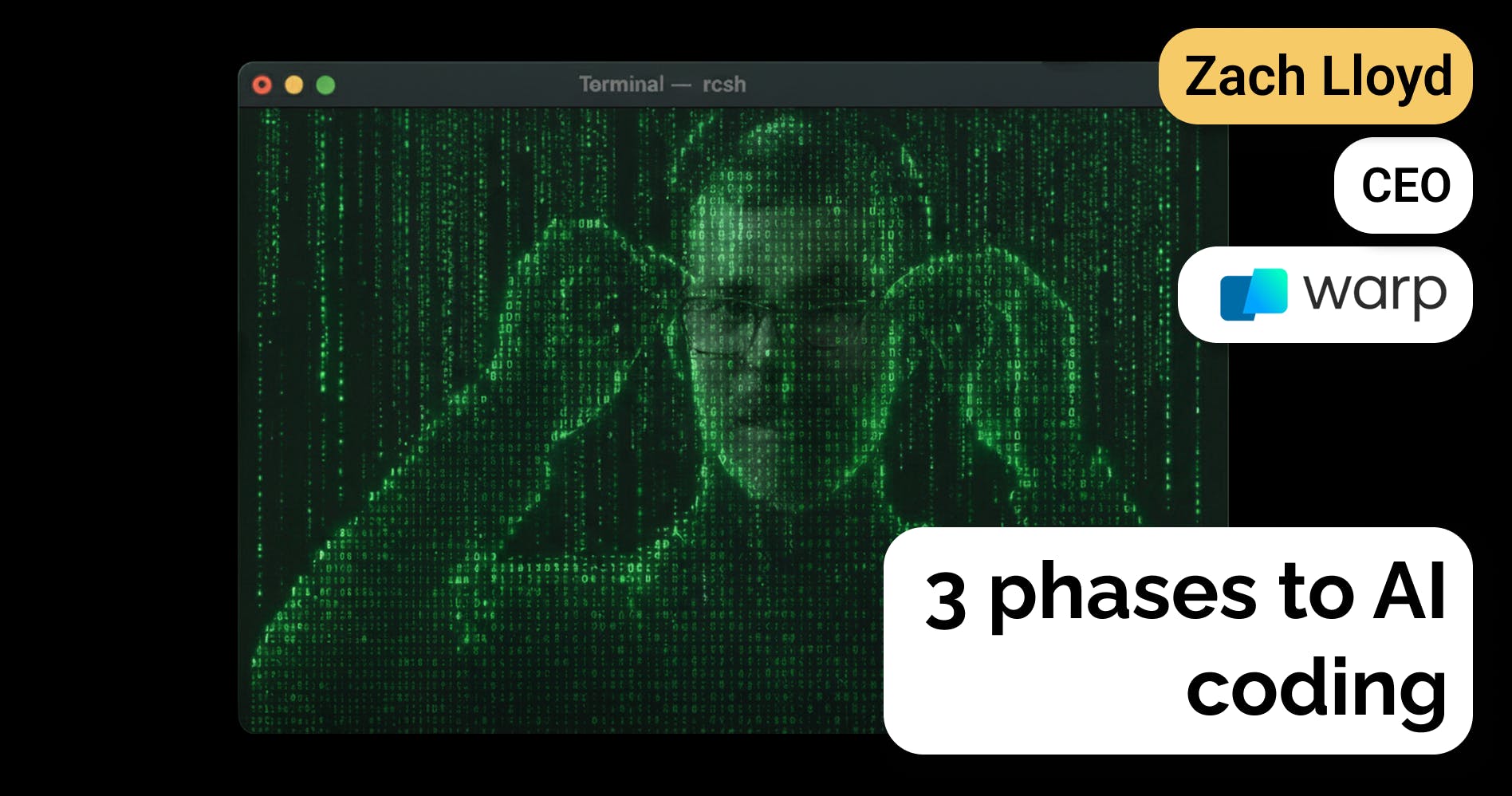Finance & ops at Replit on AI-powered development platforms and the future of coding
 Jan-Erik Asplund
Jan-Erik Asplund
Background
We spoke with a finance and operations leader at Replit who witnessed the platform's evolution from a learning tool to what they call an "internet-first operating system for coding."
Our conversation explores how Replit is challenging the "toy for beginners" misconception, its growth channels, retention dynamics, and the strategic opportunities in enterprise AI development.
Key points via Sacra AI:
- AI-powered development platforms like Replit are evolving from "toy" environments into full development operating systems that enable non-technical founders to build MVPs at 10-12x cost savings. "The core demand they tapped into was the power of product creation without the friction of becoming a developer... What platforms like Replit are doing is giving users direct access to the real thing—actual code—but eliminating the setup and friction traditionally involved."
- Structural costs from inference and infrastructure create an "AI tax" that keeps gross margins low (23% for Replit, 35% for Lovable), but platforms can expand margins through usage-aligned pricing, bundled workflows, and enterprise up-tiers. "Unlike pure software where gross margins can hit 70-90%, AI-driven development platforms carry a lot of structural costs that drag margins down in the early years... The big one is inference cost. Every time a user hits 'generate code' or runs an agent, you're paying OpenAI or Anthropic or your own GPU bills."
- Replit's growth came primarily through product-led acquisition where shared projects served as zero-CAC distribution, while retention hinges on two key metrics—successful deployments and repeat creation—with enterprise features representing the next frontier for profitability. "The biggest driver was organic and community-led growth. Replit excelled early in making the product instantly usable in the browser, which meant anyone could share a link to a project and a new user could immediately be in the coding app. That virality loop using projects as distribution accounted for a huge portion of sign-ups."
Questions
- To start broadly, what's the biggest misconception you think people have about Replit or the in-browser coding agent development space more generally?
- Can you expand on that evolution? What were some examples of workflows or features adopted by more advanced users or even teams that challenge the "toy for learners" perception?
- Did that segment show signs of longer-term adoption as their apps matured? Or did you tend to see them graduate off the platform once they hit a certain stage?
- What core demand or user need do you think platforms like Replit or Lovable tapped into that allowed them to grow so quickly in the first place?
- Is the main appeal speed of iteration, sense of ownership, or long-term control over the output? What are users telling you about what makes these tools so attractive compared to either traditional coding or no-code products?
- How would you segment Replit's audience today in terms of technical skill or usage?
- The Information reported Replit's gross margins in the first half of 2023 were around 23 percent, which is fairly low especially compared to Lovable's 35 percent. From your vantage point, what accounts for lower gross margins in this category? And what are the likeliest levers to expand them over time?
- What specific monetization strategies do you think are most promising for platforms like Replit and Lovable to increase gross margins?
- You mentioned earlier that some Replit users do eventually graduate. Could you talk more about when and where retention tends to break for these platforms? What causes churn and what actually helps reduce it?
- When churn does happen, where do these users tend to go? For example, when more advanced developers or serious teams leave Replit, what do they tend to graduate to? And why?
- Were there any user behaviors or product milestones that best predicted long-term retention while you were at Replit?
- During your time at Replit, what were the core growth channels? Where did most of the new sign-ups actually come from?
- From a CAC to LTV perspective, which of those channels or loops were most efficient? Were any growth programs surprisingly effective or underperformed?
- If you had to position Replit versus Lovable, the conversational AI app builder, where is Replit stronger than Lovable? And where does Lovable seem to have the edge?
- What would you watch most closely as a leading indicator of success in this category? What metric or behavior tells you a platform might have breakout potential or staying power?
- If you were advising Replit on where to focus or invest more over the next 12 to 24 months, what would you say? Where can they lean in hardest for durable growth and differentiation in this evolving AI coding category?
- If an enterprise wanted to embrace Replit in that way, what would an ideal enterprise SKU include to overcome typical objections from IT or security teams?
- During your time at Replit, what role did agents actually play in projects? Were users using agents autonomously, or were they mostly leaning on AI for scaffolding code snippets and ideas?
- Is there anything we haven't covered that you'd consider important for someone trying to understand how the coding agent market is evolving or where Replit sits in that broader landscape?
Interview
To start broadly, what's the biggest misconception you think people have about Replit or the in-browser coding agent development space more generally?
The biggest misconception about Replit is that it's just a toy environment for beginners. Many developers think it's only for creating simple projects. But in reality, these platforms are becoming full development operating systems. What's easy to miss is how powerful the environment has become.
Can you expand on that evolution? What were some examples of workflows or features adopted by more advanced users or even teams that challenge the "toy for learners" perception?
A good example would be the misconception that on the surface, people assume it's for students learning Python or for hobbyists building simple projects. But as we learned through community interactions, people were actually using it to build prototypes for their own startups. These solopreneurs were building MVPs and saving so much money because it would have cost them thousands for that MVP to have been built elsewhere. With Replit, with just 20 or 50 bucks, they could build that MVP themselves.
Did that segment show signs of longer-term adoption as their apps matured? Or did you tend to see them graduate off the platform once they hit a certain stage?
I've seen a split pattern for non-technical founders and solopreneurs. Replit is often the fastest way for them to get from 0 to 1. They save 10 to 12 times on development costs, which is why this segment has been very active. a16z has actually called this "the rise of the one-person unicorn factory"—the idea that AI coding tools collapse the gap between idea and MVP.
Once the app starts maturing, some of those teams do graduate to more fine-grained control and enterprise integrations. But what's interesting is there's some stickiness at the middle tier where founders aren't necessarily abandoning Replit entirely. They're using it for rapid iteration and tools. For onboarding new developers, their actual work might move to AWS. I wouldn't frame it as churn as such, but as a reduced footprint.
What core demand or user need do you think platforms like Replit or Lovable tapped into that allowed them to grow so quickly in the first place?
The core demand they tapped into was the power of product creation without the friction of becoming a developer. If you think back, the low-code/no-code wave was about letting non-technical users drag and drop their way to an app. What platforms like Replit are doing is giving users direct access to the real thing—actual code—but eliminating the setup and friction traditionally involved.
Is the main appeal speed of iteration, sense of ownership, or long-term control over the output? What are users telling you about what makes these tools so attractive compared to either traditional coding or no-code products?
What I hear most frequently is that it's actually a combination. The entry point comes first—the ability to instantly have something running in front of them. Y Combinator talks about this as well, how the cost of experimentation is a single startup's philosophy. Tools like Lovable, Replit, and Cursor significantly lower that cost.
Once users are on the platform, they appreciate the speed but also the autonomy. With traditional no-code platforms, you can't customize beyond certain limits and you get locked into a proprietary system. With Replit-style platforms, people feel like they're working with the real thing without the pain of the setup or configuration. That's the combination that makes these platforms compelling.
How would you segment Replit's audience today in terms of technical skill or usage?
Historically, the core base was individuals with coding experience. That is still a huge portion because the platform lowers the barrier to try coding in the same way that YouTube lowered the barrier to publishing video.
What changed is Replit's sophistication grew. Many users aren't just tinkering anymore—they're building serious projects and launching products and tools. That's where you see the "one-person unicorn factory" narrative. Now with an enterprise product built very recently, we're seeing some early traction from beta customers in that group as well.
The Information reported Replit's gross margins in the first half of 2023 were around 23 percent, which is fairly low especially compared to Lovable's 35 percent. From your vantage point, what accounts for lower gross margins in this category? And what are the likeliest levers to expand them over time?
These margins highlight one of the trickiest dynamics in this category. Unlike pure software where gross margins can hit 70-90%, AI-driven development platforms carry a lot of structural costs that drag margins down in the early years.
The big one is inference cost. Every time a user hits "generate code" or runs an agent, you're paying OpenAI or Anthropic or your own GPU bills. It's like having variable costs of goods tied to user engagement. That's fundamentally different from SaaS where the marginal cost of an extra query is zero. Andreessen Horowitz has written about this, calling it the "AI tax," and it shows up clearly in platforms like Replit.
The second is infrastructure sprawl. These platforms aren't just running models—they're hosting environments, file systems, and collaboration layers. That means cloud spend on storage and compute that is proportionately higher given that you're subsidizing resources for your users.
The low gross margins today aren't a flaw—they're a stage of the curve. Companies that figure out infrastructure efficiency plus smart monetization will see margins expand materially over the next few years.
What specific monetization strategies do you think are most promising for platforms like Replit and Lovable to increase gross margins?
When I talk about smart monetization in this category, I think about three main approaches:
First is usage-aligned pricing. Instead of a SaaS flat fee tied to seats, you tie the revenue to the intensity of model usage. GitHub Copilot, for example, still charges per seat, but we're already seeing other tools experiment with pricing tied to tokens consumed, number of successful builds, or deployment volume. That way, the heavy users cover more costs while light users aren't scared off.
Second is bundled workflows. If you own more of the workflow, you can offset the expensive AI steps with high-margin services. Lovable is a good example—they're not just selling code generation; they're bundling design and collaboration into one package. That's margin-accretive because they're monetizing the full workflow, not just the costly AI component.
Third is enterprise up-tiers. Self-serve users drive adoption, but gross margin expansion happens when you layer on enterprise features. Think private model hosting or dedicated support.
All these approaches together would help bend gross margins up while still scaling growth.
You mentioned earlier that some Replit users do eventually graduate. Could you talk more about when and where retention tends to break for these platforms? What causes churn and what actually helps reduce it?
Retention is one of the toughest questions in this space. It tends to break at two main inflection points.
The first is scale and complexity. Very early on, a solo founder or small team is thrilled by the speed of iteration. But as the app matures, they need more granular control over infrastructure, security, and integrations. That's when some users migrate to traditional stacks because they feel constrained.
The second is perceived cost predictability. If users hit too many AI hallucinations or they can't forecast what they'll spend on inference-heavy workflows, that erodes trust. The moment users stop believing the platform will be stable enough for production, they're likely to churn.
On the flip side, what reduces churn is workflow stickiness. If the platform isn't just a coding window but also a collaboration hub or deployment pipeline and AI assistant, you're less likely to leave. That's why Replit bundling hosting and version control features matters so much—users are leaving more than just their code if they depart.
Also, platforms that offer a smooth bridge from free to pro to enterprise tend to retain users longer. Users feel they can grow without ripping and replacing. Stripe's Patrick Collison once said that the best platforms scale with their customers' ambition, and that applies here.
When churn does happen, where do these users tend to go? For example, when more advanced developers or serious teams leave Replit, what do they tend to graduate to? And why?
When churn happens, there are usually two main destinations, and it tells you something about user intent.
More advanced developers typically graduate to traditional cloud stacks like AWS, usually paired with frameworks like Next.js or platforms like Vercel. The reason is control—they want fine-grained tuning of infrastructure, enterprise-grade compliance, and the ability to run heavier workloads at favorable cost.
The second path is toward specialized AI-augmented tools inside workflows they already know. For example, developers comfortable with VS Code might adopt GitHub Copilot. Or teams embedded in Microsoft's ecosystem might use Microsoft's AI tools. Users stick with familiar environments but want AI inside them.
There's also a smaller but growing segment of teams that move to specialized vertical platforms. Teams building AI-native agents might migrate to LangChain, Dust, or some bespoke infrastructure. Those focused on design-to-code workflows might graduate from Lovable to Figma.
Were there any user behaviors or product milestones that best predicted long-term retention while you were at Replit?
I won't share exact numbers, but the best predictors were the number of times that an agent was prompted and the number of apps that were deployed by a user.
During your time at Replit, what were the core growth channels? Where did most of the new sign-ups actually come from?
The growth architecture was quite interesting—it didn't look like a traditional SaaS funnel but closer to consumer apps.
The biggest driver was organic and community-led growth. Replit excelled early in making the product instantly usable in the browser, which meant anyone could share a link to a project and a new user could immediately be in the coding app. That virality loop using projects as distribution accounted for a huge portion of sign-ups. It's similar to how Figma grew, where every file share was a potential acquisition.
That's why one of the geographies where we saw growth was India, where there's a lot of hunger for coding, but not everyone has access to download software. The browser-based approach made it very accessible there.
The second channel was education and upskilling through partnerships with learning platforms. Some companies even used Replit as a tool for interviews because candidates and interviewers didn't need any pre-installed software.
From a CAC to LTV perspective, which of those channels or loops were most efficient? Were any growth programs surprisingly effective or underperformed?
Through a CAC to LTV lens, the most efficient channels were product-led. The project sharing loop had potentially zero CAC because when someone shared a Replit, it doubled as marketing. It also drove higher LTV because users came in already seeing real value, not just signing up to try coding.
The second efficient channel was educational partnerships with NGOs and other organizations teaching coding through Replit. That really helped us reach and convert the right audience.
Something we were exploring more toward the end of my time was traditional outbound sales once we had an enterprise product.
If you had to position Replit versus Lovable, the conversational AI app builder, where is Replit stronger than Lovable? And where does Lovable seem to have the edge?
They have overlapping but clearly distinct positioning. Replit is a general-purpose development environment—an internet-first operating system for coding, with AI agents increasingly baked into the workflow. It's like Figma for code, where individuals, teams, and classrooms can create together.
Lovable is more of a specialized builder. What it pitches is that you don't need to write much code at all—just describe what you want, and it scaffolds up a full app. That makes it more opinionated, closer to the no-code/low-code end of the spectrum, but with AI raising the ceiling so you can go further than traditional drag-and-drop tools.
The trade-off is that you get speed and simplicity with Lovable, but less flexibility compared to writing raw code in Replit.
To simplify: Replit wins with users who care about ownership and extensibility, while Lovable wins with users who want the fastest possible path to something functional and are okay with some limits on flexibility.
What would you watch most closely as a leading indicator of success in this category? What metric or behavior tells you a platform might have breakout potential or staying power?
What I would use as a metric is how quickly a user can ship something that works. The idea-to-shipping time is a great indicator. Sign-ups are just a vanity metric that doesn't matter much. But the act of shipping shows product-market fit.
For Replit, it might be the number of successful deployments. For technical founders, it might be launching something real. Another indicator would be repeat creation—if users come back to build a second or third project, that tells you they've made the platform their default canvas.
If you were advising Replit on where to focus or invest more over the next 12 to 24 months, what would you say? Where can they lean in hardest for durable growth and differentiation in this evolving AI coding category?
I think leaning more into B2B would be great because that's where profitability is. It's not just about developers coding in a browser anymore—Replit would become an innovation sandbox for enterprises.
Right now, every large company is experimenting with AI development, but most of those experiments are slowed down by security reviews, cloud setups, and compliance hurdles. Replit's advantage is the zero-setup collaborative environment. If they can harden that for enterprise with private cloud options, audit trails, and data governance, they suddenly become the fastest way for big corporations to experiment with AI. Having this sandbox layer would be valuable in the AI enterprise space.
If an enterprise wanted to embrace Replit in that way, what would an ideal enterprise SKU include to overcome typical objections from IT or security teams?
I think it would be wise to develop this by co-creating with customers rather than building it in isolation. Today everyone's still learning what the guardrails are and what ethical use of AI means.
The ideal SKU would have to directly address IT and security first, as those are usually the friction points. At minimum, the enterprise SKU needs identity and access controls—SSO, role-based permissions, audit logs so security teams can see exactly who did what.
The second must-have would be data isolation. Most tech companies won't touch a shared cloud IDE unless they know code and data are walled off, either through VPC deployment, private cloud, or with on-premise options. This is a trust model for generative AI.
From there, compliance features would be essential—SOC 2, GDPR, or HIPAA relevance where applicable. Those boxes would have to be ticked because procurement won't move forward without them. It's table stakes for enterprise adoption.
During your time at Replit, what role did agents actually play in projects? Were users using agents autonomously, or were they mostly leaning on AI for scaffolding code snippets and ideas?
It's an important distinction because there's a lot of hype around fully autonomous agents right now. In practice, during my time at Replit, agents were used for scaffolding, partnering, and as independent coders, but I've heard that has changed more recently.
Most users were really using AI for generating boilerplate, debugging snippets, or suggesting next steps—something like supercharged autocomplete, not truly autonomous coding. More recently, agents have started to show autonomy on bounded tasks.
Is there anything we haven't covered that you'd consider important for someone trying to understand how the coding agent market is evolving or where Replit sits in that broader landscape?
If I had to highlight one thing, it would be that the coding agent market isn't really about code anymore. It's about who gets to participate in software creation.
Today, Replit sits at a very interesting intersection. On one side, it competes with professional IDEs, making individual developers more productive. On the other hand, you have Lovable-style builders which are abstracting everything away for speed. Replit's edge is that it gives you real code with no friction, positioning it uniquely as both an on-ramp for new creators and a powerful tool for experienced ones.
The broader evolution is moving from AI as an assistant to AI as a co-creator. Gartner research suggests that over the next few years, they expect more than half of enterprise code will be touched by AI in some way. The winners in this category will be those harnessing the power of AI to get more people building software. We're moving from a world of scarce to abundant creation platforms.
Disclaimers
This transcript is for information purposes only and does not constitute advice of any type or trade recommendation and should not form the basis of any investment decision. Sacra accepts no liability for the transcript or for any errors, omissions or inaccuracies in respect of it. The views of the experts expressed in the transcript are those of the experts and they are not endorsed by, nor do they represent the opinion of Sacra. Sacra reserves all copyright, intellectual property rights in the transcript. Any modification, copying, displaying, distributing, transmitting, publishing, licensing, creating derivative works from, or selling any transcript is strictly prohibited.








